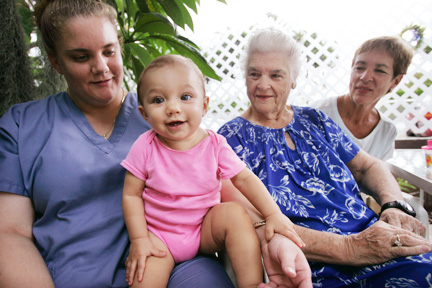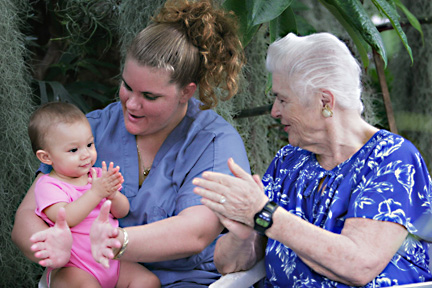|

Cassandra Keiper, with daughter Yetlanezi, 9 months, Kaye Wuest and Nancy Keiper met to talk about working in Hawaii.
Family sees fewer
barriers over time
Three kin have collectively
witnessed the evolution of
women’s liberation
During the summers of the early 1990s, Nancy Keiper would drive her dump truck to jobs around the island in a swimsuit top and shorts. Her daughter, in grade school at the time, usually came along. She'd wear a bikini.
|
|
On those hot days and in that massive truck's un-air-conditioned cab, the show -- the truck driving, the swimsuit-wearing, the eyebrow-plucking -- was Keiper's way of making a statement to anyone who cared to listen. It was her way of screaming for women's equal rights without employing the loud, picket-line tactics of the 1960s women's movement, which she never liked or joined. It was her way of l eading by example -- for her daughter -- and following the example of her mother, who quietly nurtured a career and raised a family during a time when few women had both.
On a recent afternoon, the three sit in their Kailua garage, laughing over Keiper's account of her summer trucking days.
"That was women's liberation," Keiper tells them, earnestly. Her mother, Kaye Wuest, giggles and shakes her head. Her daughter, Cassandra, smiles.
Here are three women of three generations -- grandmother, mother, daughter -- whose lives are remarkably different. Wuest was born in 1920, the same year women got the right to vote. Her granddaughter came into the world more than six decades later, a year after Sandra Day O'Connor became the first woman on the U.S. Supreme Court.
In many ways, their stories represent those of their peers. Wuest started her family at the height of World War II. When her husband was away on naval ships, she headed up the household and brought home a steady wage as a teacher.
Keiper grew up seeing gender discrimination all around her and thinking it was perfectly natural. She scoffed, but didn't argue, when her father told her she couldn't have a car because she was a girl.
Cassandra Keiper, at 23, sees few barriers for women in her world. Every door she's ever encountered is wide open. If she sees something she doesn't like, she protests against it loudly. "I think women should speak up about their rights," she said. "You don't get anywhere when you're quiet."
When it comes to where women are now and how far they've come, the trio agree on little. They only hope life will be barrier-less -- that gender won't be an issue -- when Cassandra's 9-month-old daughter, Yetlanezi, comes of age.
"I am amazed at the differences between my mother's generation and my daughter's generation," Nancy Keiper said, while cutting out wooden letters for a Chaminade University sign in her workshop. She works for a construction company. It's not truck driving, she says, but pretty darn close.

Several women from different generations of one family gathered yesterday to talk about their experiences. Taking a break were Cassandra Keiper, her daughter Yetlanezi Yaxpak-Keiper, 9 months, and Yetlanezi's great-grandmother, Kaye Wuest.
In 1942, a year after she graduated with her teaching degree, she married. Her husband, Bob, was a graduate of the U.S. Naval Academy. And when World War II started, he was shipped off to the Pacific. "The war came, that was his business," Wuest explained, matter-of-factly. She stayed behind in San Diego, teaching music in public schools.
Their first child was born in 1945. Their last, Keiper, was born in 1950. While Wuest's husband was off to war, she raised her children and kept her job. When he came back, they moved and moved and moved -- to naval bases in Maryland, Massachusetts, California and elsewhere.
In the early '50s, while they were in Washington, Wuest saw an ad for teachers and decided to apply. At the time, she said, most married women -- especially those in the upper-middle class -- didn't work. But the school was desperate, and she had her degree.
The job was a subtle grab for equal rights -- a quiet way of pursuing her career, while still taking care of her family. "My husband assumed the head of the household and that was fine with me," Wuest said, while sitting in the Kailua home she shares with her daughter and grandchildren. "When the babies came, I had the responsibility for them."
In 1959, Wuest's husband retired. He wanted to get out of the Navy while he was still young enough to work. The family moved to the islands, where they set up in Kailua, and Bob Wuest, at 42, started a new career at an insurance company.
For several years, Kaye Wuest was a substitute at public schools. Then she started teaching private piano lessons in her home and had at least 25 students, until she retired in 1995. Her husband died in 1973, at 57 years old. "When he left to fight a war, I had a choice of either sitting down and weeping or getting the most out of what I had," Wuest said, adding that she took on the same attitude when he died, deciding to get involved in her community and church rather than give up on life.
IN THE EARLY '90s, truck drivers didn't take kindly to seeing a woman in their ranks. "They'd stop and they'd look at you, really annoyed," Keiper said, in a light-hearted tone. "They'd say, 'Oh God, it's a damn broad.'"
But Keiper didn't care. She loved driving trucks. It was more exciting, more gratifying than all the jobs she'd held before -- teacher, waitress, secretary, Avon sales representative.
Keiper was born in California, but came to the islands when she was still in grade school. She was the first girl to be born to a Wuest in three generations, and her father didn't quite know what to do with a daughter. "He disciplined me as one of the boys," Keiper said.
But he also treated her differently than her brothers, sticking to the social expectations of the time -- an earlier curfew, no dates until she was 16.
In 1972, Keiper married. She was too young and the relationship didn't last but five years. They had a son together and Keiper raised him. She married again in 1978 -- this time for 25 years. Her divorce was peaceable, and the result of a lot of thinking.
"I was not going to live my life being with a person I'm terribly unhappy with," she said. "I'm independent; I don't kowtow to anybody."
Keiper said she learned how to do what she wanted as a woman from her mother. "She taught me the different times and places to have an opinion," Keiper said, lovingly. "She also taught me to go without, humbly. She gave up her career, and yet she didn't."
WHEN CASSANDRA Keiper graduated from high school, she wasn't sure what she wanted to do. So she drifted from one minimum-wage job to another -- Domino's Pizza, Papa John's Pizza, Airborne Express. She moved to Washington in 2002, where she was a telemarketer and worked for a casino. She enrolled in massage school, but soon dropped out.
But when she got pregnant, everything changed. She and her boyfriend moved back to Hawaii in April, and Keiper signed up for Job Corps, which offers vocational training to young people. She wants to become a nurse's assistant, and has dreams of becoming a doctor.
"Having a kid changes your perspective on life," she said, as she sat with her infant after a day of classes. Keiper sees big differences between her mother's generation and her own. Everything was strict and proper then, she says. Where was the freedom?
She doesn't even try to understand what it was like for her grandmother.
Tracking Time
1981 ~ 1990Key dates in women's empowerment in Hawaii:
» 1981: Anna Maria Brault became the city's first female director of health.
» 1982: Faith Evans was appointed the state's first female U.S. Marshall.
» 1983: Brigadier Gen. Frances Iwalani Mossman became the first woman to achieve the rank of general in any of the U.S. Armed Forces.
» 1985: Karen Nakamura was appointed the first woman president of the Building Industry Association of Hawaii.
» 1986: Sister Grace Dorothy Lim was named the first woman chancellor of the Roman Catholic Diocese of Honolulu.
» 1990: Now-Gov. Linda Lingle was elected Maui's first woman mayor.
E-mail to City Desk
[News] [Business] [Features] [Sports] [Editorial] [Do It Electric!]
[Classified Ads] [Search] [Subscribe] [Info] [Letter to Editor]
[Feedback]
